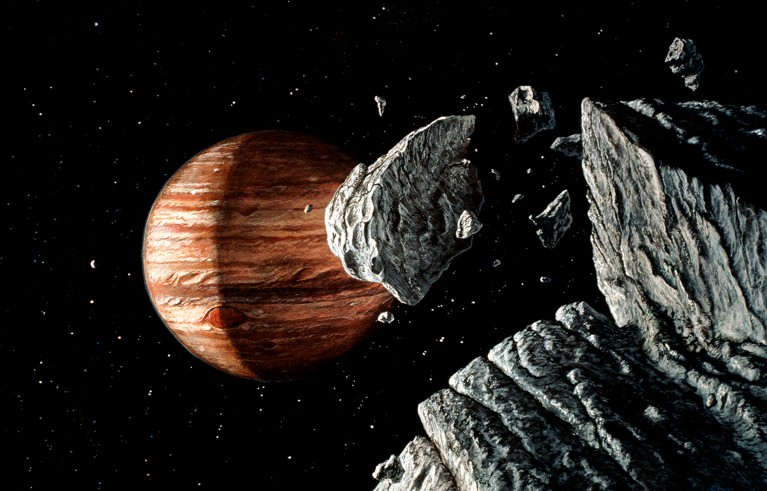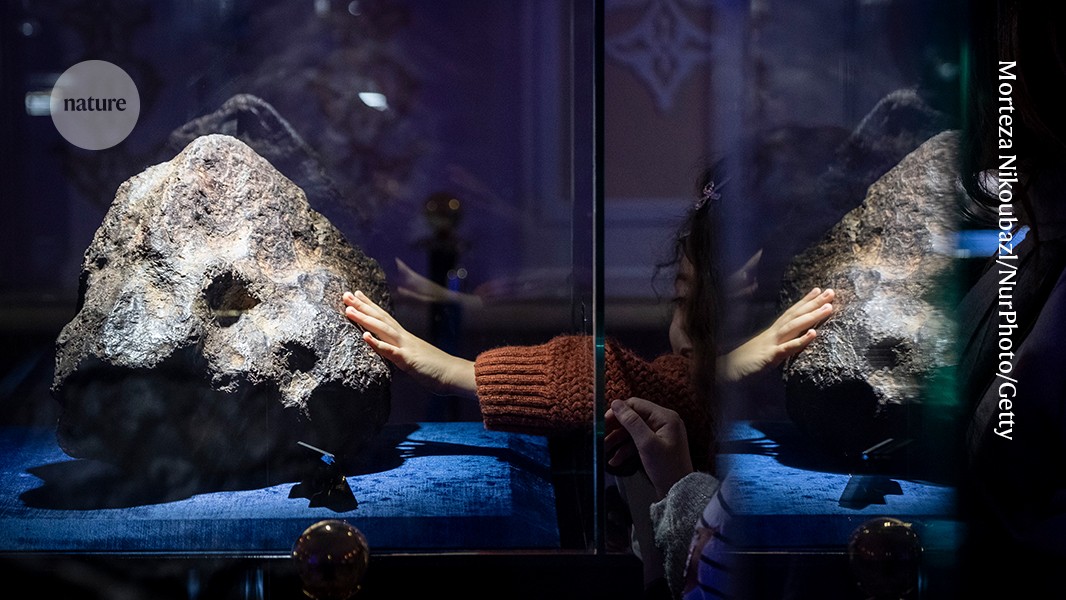The Meteorite Hunters: On the Trail of Extraterrestrial Treasures and the Secrets Inside Them Joshua Howgego Oneworld (2025)
The Meteorites: Encounters with Outer Space and Deep Time Helen Gordon Profile (2025)
From vacuuming cathedral rooftops to traversing the frozen wastes of Antarctica, people go to great lengths to find the landfall of shooting stars. That is the take-home message of two adventurous books about the people who hunt for, collect, research and trade in meteorites.
In The Meteorite Hunters, journalist Joshua Howgego takes a broad look at these rocks that fall from the skies, discussing, for instance, their complex chemistry and role in the dinosaurs’ extinction, and revealing the stories of the people who cross continents to find them. And in The Meteorites, natural historian Helen Gordon relates tales of witnessed meteorite impacts and expeditions to find these tantalizing treasures. Both books are enjoyable reads, with deftly written portraits of scientists, dealers and hunters.
Space oddity
What is behind meteorites’ allure? These space rocks bring the unknown Universe down to Earth, and within reach. Yet, meteoritics wasn’t always an accepted discipline, Howgego explains in The Meteorite Hunters. These unusual rocks remained the preserve of folk stories until, in the late eighteenth century, German physicist Ernst Chladni looked through accounts about meteorites found around the world and noticed how similar they were.

US explorers took the Innaanganeq (or Cape York) meteorite from Greenland in 1895.Credit: Chroma Collection/Alamy
Scientists now know that meteorites fall regularly, and have done so throughout Earth’s history. Their compositions range from metal to stone, and their sizes from dust to kilometre-sized chunks capable of causing mass extinctions — such as the meteorite that wiped out the dinosaurs some 66 million years ago. Researchers have also found that meteorites come mainly from asteroids, although a rare few are fragments of the Moon or Mars.
Space debris is falling from the skies. We need to tackle this growing danger
The people who look for meteorites are just as varied. The 2009 television series Meteorite Men shows macho hunters touring the planet to collect fragments. Scientists mount more-organized expeditions to find meteorites at the end of trails made by observed fireballs — like searching for the treasure at the end of a rainbow. Antarctica has provided humanity with the most meteorites. With its freezing temperatures and extremely dry conditions, it provides perfect storage conditions. Glaciers’ ice flows concentrate meteorites in certain regions, making it easier to retrieve the rocks by the hundreds.
But it is not necessary to travel to exotic places. At least 1,000 tonnes of cosmic dust grains fall on Earth each year. On a grey day in Oslo, Howgego joins a rooftop search hosted by urban micrometeorite collector Jon Larsen. Despite a few hiccups — rain, tall ladders to climb and bags that split — it proved to be a highly successful search.
In April 2019, a meteorite shower in Costa Rica made the news; a dog kennel it had crushed was subsequently sold at auction for US$44,000. I was relieved to learn that the kennel’s resident, aptly named Rocky, was unscathed. As an aside, the meteorite dealer who bought most of this particular rock admitted that he ate a tiny piece of each of his acquisitions — a foolhardy thing to do, given that meteorites can contain teeth-breaking diamonds and tarry polyaromatic hydrocarbons.

Parts of Antarctica have just the right conditions to preserve lots of meteorites.Credit: NASA Photo/Alamy
Howgego discusses why meteorites — sweeping the story back 4.5 billion years, to the start of the Solar System — are such treasured scientific objects. By analysing the meteorites’ isotope ratios, he explains, scientists can identify whether the sample came from the rocky inner Solar System or the icy outer Solar System. And meteorites could be products of crashes between young planets and asteroids as they careered through the early Solar System. He also delves deep into theories about how Earth came to host its oceans (spoiler: there’s still no consensus.)
In short, The Meteorite Hunters is wonderfully engaging, admirably accurate and up to date — a must-read for budding planetary scientists.
Out of this world
The Meteorites is another account brimming with personal stories of witnessed meteorite impacts and expeditions to find the fallen rocks. From mysterious iron beads that were revered in ancient Egypt to a residential street in a pretty town in the Cotswolds, UK, where a meteorite fell in 2021, Gordon skilfully weaves together narratives that cross time periods and continents. Her curiosity about how meteorite enthusiasts gained their fascination shines through.
At the National Museum of Brazil in Rio de Janeiro, Gordon meets astronomer Maria Zucolotto, who notes, “When I touch a meteorite, I touch space.” Unfortunately, the museum’s collections were damaged by a devastating fire in 2018. Curators tried to save their treasures but were sadly beaten back by flames and many artefacts were lost. Meteorites might have survived for 4.5 billion years, yet sometimes human disasters are too much for even them to bear.

Pieces of the comet Shoemaker–Levy 9 crashed into Jupiter in 1994 (artist’s impression).Credit: Chris Butler/SPL



